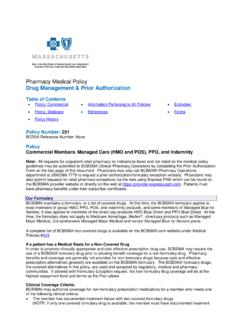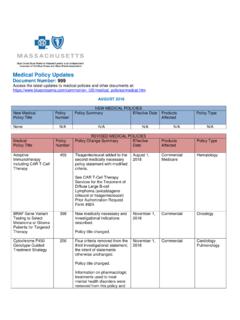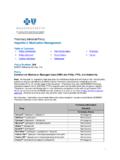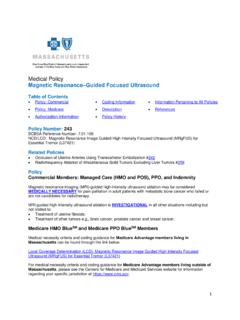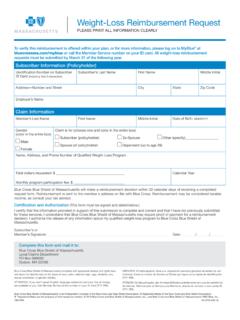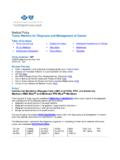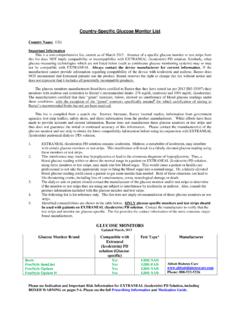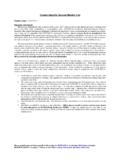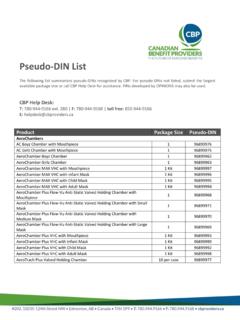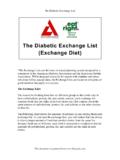Transcription of 107 Continuous or Intermittent Monitoring of …
1 1 Medical Policy Continuous or Intermittent Monitoring of glucose in Interstitial Fluid Table of Contents Policy: Commercial Coding Information Information Pertaining to All Policies Policy: Medicare Description References Authorization Information Policy History Policy Number: 107 BCBSA Reference Number: NCD/LCD: Local Coverage Determination (LCD): glucose Monitors (L33822) Related Policies Artificial Pancreas Device Systems, #720 Policy Commercial Members: Managed Care (HMO and POS), PPO, and Indemnity Continuous Monitoring (ie, long-term) Monitoring of glucose levels in interstitial fluid, including real-time Monitoring , as a technique of diabetic Monitoring , including devices with low glucose suspend (LGS features), may be considered MEDICALLY NECESSARY when the following situations occur, despite use of best practices.
2 Patients with type 1 diabetes that is not adequately controlled (A1c > ) who have demonstrated an understanding of the technology, are motivated to use the device correctly and consistently, are expected to be adherent to a comprehensive diabetes treatment plan supervised by a qualified provider, and are capable of using the device to recognize alerts and alarms; or Patients with type I diabetes who have recurrent, unexplained, severe, (generally blood glucose levels <50 mg/dl) hypoglycemia or impaired awareness of hypoglycemia that puts the patient or others at risk; or Patients with poorly controlled type I diabetes who are pregnant. Poorly controlled type 1 diabetes includes unexplained hypoglycemic episodes, hypoglycemic unawareness, suspected postprandial hyperglycemia, and recurrent diabetic ketoacidosis.
3 Intermittent Monitoring (ie, 72 hours)* of glucose levels in interstitial fluid may be considered MEDICALLY NECESSARY in patients with type I diabetes whose diabetes is poorly controlled, despite current use of best practices.* Poorly controlled type 1 diabetes includes the following clinical situations: unexplained hypoglycemic episodes, hypoglycemic unawareness, suspected postprandial hyperglycemia, and recurrent diabetic ketoacidosis. *Best practices in diabetes control include compliance with a regimen of 4 or more finger sticks each day and use of an insulin pump. During pregnancy, 3 or more insulin injections daily could also be considered 2 best practice for patients not on an insulin pump prior to the pregnancy.
4 Prior use of an Intermittent (72-hour) glucose monitor would be considered a part of best practices for those considering use of a Continuous glucose monitor. Intermittent Monitoring * of glucose levels in interstitial fluid may also be considered MEDICALLY NECESSARY in patients with type 1 diabetes prior to insulin pump initiation to determine basal insulin levels. * Intermittent Monitoring is generally conducted in 72-hour periods. It may be repeated at a subsequent time depending on the patient s level of diabetes control. Other uses of Continuous Monitoring of glucose levels in interstitial fluid as a technique of diabetic Monitoring are considered INVESTIGATIONAL.
5 Medicare HMO BlueSM and Medicare PPO BlueSM Members Medical necessity criteria and coding guidance for Medicare Advantage members living in Massachusetts can be found through the link below. Local Coverage Determination (LCD): glucose Monitors (L33822) For medical necessity criteria and coding guidance for Medicare Advantage members living outside of Massachusetts, please see the Centers for Medicare and Medicaid Services website for information regarding your specific jurisdiction at Prior Authorization Information Inpatient For services described in this policy, precertification/preauthorization IS REQUIRED for all products if the procedure is performed inpatient.
6 Outpatient For services described in this policy, see below for products where prior authorization might be required if the procedure is performed outpatient. Outpatient Commercial Managed Care (HMO and POS) Prior authorization is not required. Commercial PPO and Indemnity Prior authorization is not required. Medicare HMO BlueSM Prior authorization is not required. Medicare PPO BlueSM Prior authorization is not required. CPT Codes / HCPCS Codes / ICD Codes Inclusion or exclusion of a code does not constitute or imply member coverage or provider reimbursement. Please refer to the member s contract benefits in effect at the time of service to determine coverage or non-coverage as it applies to an individual member.
7 Providers should report all services using the most up-to-date industry-standard procedure, revenue, and diagnosis codes, including modifiers where applicable. The following codes are included below for informational purposes only; this is not an all-inclusive list. For members with a pharmacy benefit: A9276: Sensor; invasive ( , subcutaneous), disposable, for use with interstitial Continuous glucose Monitoring system, one unit=1 day supply Note: If a member does not have a pharmacy benefit, the above noted item would be covered according to the member s benefit and certificate language. 3 The above medical necessity criteria MUST be met for the following codes to be covered for Commercial Members: Managed Care (HMO and POS), PPO, Indemnity, and Medicare HMO Blue and Medicare PPO Blue: CPT Codes CPT codes: Code Description 95250 Ambulatory Continuous glucose Monitoring of interstitial tissue fluid via a subcutaneous sensor for a minimum of 72 hours; hook-up, calibration of monitor, patient training, removal of sensor, and printout of recording 95251 Ambulatory Continuous glucose Monitoring of interstitial tissue fluid via a subcutaneous sensor for a minimum of 72 hours.
8 Interpretation and report HCPCS Codes HCPCS codes: Code Description E0784 External ambulatory infusion pump, insulin A9276 Sensor; invasive ( , subcutaneous), disposable, for use with interstitial Continuous glucose Monitoring system, 1 unit=1 day supply A9277 Transmitter; external, for use with interstitial Continuous glucose Monitoring system A9278 Receiver (monitor); external, for use with interstitial Continuous glucose Monitoring system The following ICD Diagnosis Codes are considered medically necessary when submitted with the CPT and HCPCS codes above if medical necessity criteria are met: ICD-10 Diagnosis Codes ICD-10-CM Diagnosis codes: Code Description Type 1 diabetes mellitus with ketoacidosis without coma Type 1 diabetes mellitus with ketoacidosis with coma Type 1 diabetes mellitus with diabetic nephropathy Type 1 diabetes mellitus with diabetic chronic kidney disease Type 1 diabetes mellitus with other diabetic kidney complication Type 1 diabetes mellitus with unspecified diabetic retinopathy with macular edema Type 1 diabetes mellitus with unspecified diabetic retinopathy without macular edema Type 1 diabetes mellitus with mild nonproliferative diabetic retinopathy with macular edema.
9 Right eye Type 1 diabetes mellitus with mild nonproliferative diabetic retinopathy with macular edema, left eye Type 1 diabetes mellitus with mild nonproliferative diabetic retinopathy with macular edema, bilateral Type 1 diabetes mellitus with mild nonproliferative diabetic retinopathy with macular edema, unspecified eye Type 1 diabetes mellitus with mild nonproliferative diabetic retinopathy without macular edema, right eye Type 1 diabetes mellitus with mild nonproliferative diabetic retinopathy without macular edema, left eye Type 1 diabetes mellitus with mild nonproliferative diabetic retinopathy without macular edema, bilateral 4 Type 1 diabetes mellitus with mild nonproliferative diabetic retinopathy without macular edema, unspecified eye Type 1 diabetes mellitus with moderate nonproliferative diabetic retinopathy with macular edema, right eye Type 1 diabetes mellitus with moderate nonproliferative diabetic retinopathy with macular edema, left eye Type 1 diabetes mellitus with moderate nonproliferative diabetic retinopathy with macular edema, bilateral Type 1 diabetes mellitus with moderate nonproliferative diabetic retinopathy with macular edema, unspecified eye Type 1 diabetes mellitus with moderate nonproliferative diabetic retinopathy without macular edema.
10 Right eye Type 1 diabetes mellitus with moderate nonproliferative diabetic retinopathy without macular edema, left eye Type 1 diabetes mellitus with moderate nonproliferative diabetic retinopathy without macular edema, bilateral Type 1 diabetes mellitus with moderate nonproliferative diabetic retinopathy without macular edema, unspecified eye Type 1 diabetes mellitus with severe nonproliferative diabetic retinopathy with macular edema, right eye Type 1 diabetes mellitus with severe nonproliferative diabetic retinopathy with macular edema, left eye Type 1 diabetes mellitus with severe nonproliferative diabetic retinopathy with macular edema, bilateral Type 1 diabetes mellitus with severe nonproliferative diabetic retinopathy with macular edema, unspecified eye Type 1 diabetes mellitus with severe nonproliferative diabetic retinopathy without macular edema, right eye Type 1 diabetes mellitus with severe nonproliferative diabetic retinopathy without macular edema, left eye Type 1 diabetes mellitus with severe nonproliferative diabetic retinopathy without macular edema, bilateral Type 1 diabetes mellitus with severe nonproliferative diabetic retinopathy without macular edema, unspecified eye Type 1 diabetes mellitus with proliferative diabetic retinopathy with macular edema.
